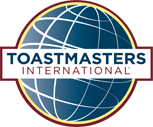
TABLE TOPICS MASTER FUNCTION
The Table Topics Master, or Topicmaster for short, gives everyone an opportunity to participate in a Toastmaster meeting. No member or visitor should attend a meeting and not have an opportunity to share something with the group. Being the Topicmaster is a fun and creative experience, and it takes about the same amount of preparation time as for a prepared speech.
Materials:
- A copy of the meeting’s agenda
- Pencil or pen
- Two copies of the word of the day, in large lettering
- A list of questions for the participants
Chronology of the Topicmaster Role:
1) A week before the meeting, work with the Toastmaster in determining the theme.
2) Choose the "word of the day"--a word that is not often used, but which will fit into daily conversation, to help Toastmasters build their vocabulary. Inform the Toastmaster of the word and its meaning, so that it can be added to the meeting agenda.
3) Write up a list of several questions, such that the participants can be spontaneous, but will sustain the general theme. Suggestions for Table Topics programs are included at the end of this document.
4) Gather up props, music or other things that will help set the mood of the meeting, concurrent with its theme. Consider dressing up or wearing badges, hats, etc. as appropriate to the meeting.
5) Two days prior to the meeting, send your introduction to the Toastmaster, and get the Toastmaster’s introduction. Type up a script for the Table Topics, if it will help.
6) The day of the meeting, make sure to have the materials above. Arrive early enough to set up any props. Hang up the word of the day on the lectern and on the wall, but held up in such a way as not to reveal it. Note: If speeches are given first, hang up the pages at the break.
7) As the meeting begins, with agenda in hand, write down all the attendants that do not have a specified function in the meeting. Try to match up individuals with questions. Note how much time has been allotted for the Table Topics session, and determine the number of contestants (assume about 3 minutes per speaker).
8) Once introduced, reiterate the day’s theme, and insert an appropriate anecdote. Keep your comments to a minimum during the session--remember that the purpose is to let others speak.
9) Reveal the word of the day, its meaning, and use it in a sentence.
10) Ask the Lexicologist to note who uses the word of the day, and encourage him/her to use the bell for "ahs" and "ums".
11) Give the timing instructions. Typically they are: Green light at one minute, amber light at 1:15, red light at 1:30, and lead applause at two minutes. Mention how long each speaker must speak as a minimum in order to qualify for best Table Topics (usually one minute). If time is tight for the meeting, it is better to shorten the time for each speaker than to reduce the number of participants. Remember, we want every person present to have the opportunity to speak at each meeting.
12) Call on each participant one by one, giving their name, encouraging them to use the word of the day. Remember to first call on those people who are not on the agenda. If time permits, you may ask guests if they want to participate (don’t coerce them), and then call on those with minor roles in the meeting. Traditionally, we do not call upon the General Evaluator--you run the risk of getting the Flake award. If time still permits, you can throw out a question for volunteers.
13) When the last speaker is finished, call upon the Lexicologist for who used the word of the day.
14) Call upon the Timer for who spoke for the required minimum time.
15) Call for the vote for best Table Topics. Prior to the vote, some Topicmasters like to summarize the message of each speaker, time permitting.
16) Introduce the Toastmaster.
17) If speeches come after Table Topics, remove the word of the day banners from the lectern and the wall.
18) When asked by the Toastmaster, present the best Table Topics award.
19) At the end of the meeting, gather up any props or other materials you brought for table topics.
SUGGESTIONS FOR TABLE TOPIC PROGRAMS
* Propose a solution to a problem in the community--seek out opposing views as well.
* Ask participants to share personal experiences, their likes or dislikes
* Give participants newspaper headlines and ask them to share their thoughts
* Ask participants to use their imaginations, and ask "what if" type questions.
* Ask participants to role play--a college football coach, a politician, a newscaster
* Start a story, and ask each participant to continue with the story
Sample theme and questions: Independence Day
* What is your favorite patriotic song, and why?
* What are you planning to do on July 4?
* Tell us a story about the most mischievous thing you’ve ever done on July 4.
* Do you have a family tradition surrounding this day? Tell us about it.
* Do they have a July 4 in France?
* Tell us why you think the USA is the best darn country on the planet.
Printer Friendly Version
